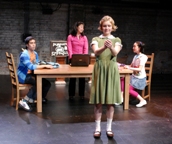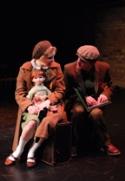Audience Participation
Permanent link All Posts

A glimpse into Hana's world
A single light illuminates a plain, solitary suitcase, creating what will be the last solitary moment of the Chicago Children’s Theatre production of Hana’s Suitcase.
Emil Sher’s adaptation of Karen Levine’s book records the real life experiences of a Czechoslovakian family’s life under Nazi occupation, a history that might have been lost were it not for the efforts of Japanese school children sixty years later, and half a world away.
The mysterious suitcase arrives at the Tokyo Holocaust Educational Resource Center and along with their teacher, students attempt to discover its owner, Hana Brady, and tell her story. In telling her story, they also tell the story of one and a half million Jewish children who perished during the Holocaust.
As they set out to find the answers, their teacher stresses the importance of the task and prepares them for what might lie ahead: “Stories can die if there is no one to tell them…If Hana’s story ends in ways that leave us terribly upset, sadder than sad, we must find a way out of the sadness. Agreed?”
And, as the audience, we do agree, because under the direction of Sean Graney, Hana’s Suitcase also becomes our story, our experience. We watch as the students learn about Hana, but we are also, by design, watching each other.

The set is sparse and the audience is arranged on either side of the stage. Large projection screens are positioned above the audience and the action continuously surrounds the seating area. Even as we watch the performers we are watching the audience situated along the opposite side of the space, a living backdrop, mirror and critic.
I typically hate this sort of arrangement. Having spent years plagued by the ever-present stage fright and insecurities of a young actor, I am now more than happy to watch from the shadows. The idea that a good number of people might be watching my reactions is usually enough to stifle any true emotion a performance might illicit. I am a truly ugly crier.
But I cried through Hana’s Suitcase, and so did a number of folks opposite me. We laughed at times, or sighed, and people hugged their children closer to them and kids crawled into their parents’ laps.
It’s impossible to watch this production as an individual, because as much as the play is the story of Hana Brady, it is also a conversation about community and our responsibility to one another: to remember the past and to tell these histories to each other and to our children.
Although Hana’s Suitcase is a children’s production, it is not easy to watch. Some of the imagery is haunting, even terrifying, and the inhumanities—the concentration camps, the murders—are never glossed over. Characters die, if not in front of us, than just out of sight, and even harder to watch are the reactions of those left behind. Watching Hana walk bravely towards the gas chamber is one of the most harrowing, horrifying things I have seen on stage.
And that is perhaps the greatest strength of this production. The audience, both children and adults, is asked to be brave. We must live these events, as hard as they may be, and then, as the Japanese students have done, tell and retell these stories so that they may not be forgotten: “Stories can die if there is no one to tell them.”
With this production, Chicago Children’s Theatre has given Hana Brady’s story new life, and with its retelling, our commitment to community and remembrance is renewed as well.
Running now through May 11. Tickets



.jpg)



